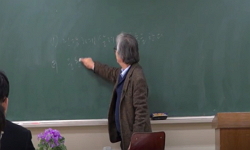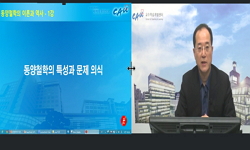This study was concerned with the inherent characteristics of Oriental martial arts, but considers first differences in Eastern and Western thought. After this, it looks into the influences that Oriental philosophy had on martial arts` thought and pri...
http://chineseinput.net/에서 pinyin(병음)방식으로 중국어를 변환할 수 있습니다.
변환된 중국어를 복사하여 사용하시면 됩니다.
- 中文 을 입력하시려면 zhongwen을 입력하시고 space를누르시면됩니다.
- 北京 을 입력하시려면 beijing을 입력하시고 space를 누르시면 됩니다.
https://www.riss.kr/link?id=A100581207
- 저자
- 발행기관
- 학술지명
- 권호사항
-
발행연도
2011
-
작성언어
Korean
- 주제어
-
등재정보
KCI등재
-
자료형태
학술저널
- 발행기관 URL
-
수록면
55-63(9쪽)
-
KCI 피인용횟수
0
- DOI식별코드
- 제공처
- 소장기관
-
0
상세조회 -
0
다운로드
부가정보
다국어 초록 (Multilingual Abstract)
This study was concerned with the inherent characteristics of Oriental martial arts, but considers first differences in Eastern and Western thought. After this, it looks into the influences that Oriental philosophy had on martial arts` thought and principles. Further, it analyzes how Oriental martial arts` thought and principles are applied during the training process, and it intends to draw a conclusion about Oriental martial arts` special characteristics. The results are as following: First, traditional Oriental thought is intuitive, holistic, and places importances on harmony. Second, traditional Oriental thought had direct influenced on the formation of Oriental martial arts` principals. Third, Oriental martial arts` principals are flexible applied according to training and ones human nature. In conclusion, Oriental martial arts` values are inherently different from Western competition sports in its characteristics regarding the constitution of basic principals, which are derived from Oriental philosophy. The training system and techniques are applied directly, and the training process for simple fighting technique instruction, of different levels, is applied to the Oriental life style. Wisdom is instructed in an holistic educational manner.
참고문헌 (Reference)
1 김창룡, "일본무도의 수련체계에 관한 고찰" 3 (3): 179-194, 2001
2 장희익, "삶과 온 생명 새 과학문화의 모색" 솔출판사 1998
3 박순진, "무도이론의 기초개념으로서의 강유론" 용인대학교 11 (11): 23-36, 2000
4 송형석, "동양무술의 기원과 발달에 관한 일고" 한국사회체육학회 17 (17): 61-72, 2002
5 허건식, "동양무도의 문화적 해석에 관한 연구" 용인대학교 대학원 2002
6 김하태, "동서철학의 만남" 종로서적 1988
7 소야승민, "가노지고로의 유도사상, 노자사상의 영향, 21 세기 무도의 전망" 34-36, 2000
8 김제범, "가노지고로(嘉納治五郞)의 생애와 교육사상에 관한 연구" 연세대학교 대학원 1999
9 박종구, "陳氏太極拳圖說" 밝은빛 2003
10 老子, "道德經"
1 김창룡, "일본무도의 수련체계에 관한 고찰" 3 (3): 179-194, 2001
2 장희익, "삶과 온 생명 새 과학문화의 모색" 솔출판사 1998
3 박순진, "무도이론의 기초개념으로서의 강유론" 용인대학교 11 (11): 23-36, 2000
4 송형석, "동양무술의 기원과 발달에 관한 일고" 한국사회체육학회 17 (17): 61-72, 2002
5 허건식, "동양무도의 문화적 해석에 관한 연구" 용인대학교 대학원 2002
6 김하태, "동서철학의 만남" 종로서적 1988
7 소야승민, "가노지고로의 유도사상, 노자사상의 영향, 21 세기 무도의 전망" 34-36, 2000
8 김제범, "가노지고로(嘉納治五郞)의 생애와 교육사상에 관한 연구" 연세대학교 대학원 1999
9 박종구, "陳氏太極拳圖說" 밝은빛 2003
10 老子, "道德經"
11 伏羲氏, "周易"
12 Eugen Herrigel, "Zen in the Art of Archery" Random House 1953
동일학술지(권/호) 다른 논문
-
- 한국사회체육학회
- 김현식(Hyun Sik Kim)
- 2011
- KCI등재
-
- 한국사회체육학회
- 조남흥(Nam Heung Cho)
- 2011
- KCI등재
-
- 한국사회체육학회
- 김은희(Eun Hui Kim)
- 2011
- KCI등재
-
해양/수상레저스포츠 참가자의 기본심리욕구, 운동정서 및 활력촉진의 관계
- 한국사회체육학회
- 김성문(Sung Mun Kim)
- 2011
- KCI등재
분석정보
인용정보 인용지수 설명보기
학술지 이력
| 연월일 | 이력구분 | 이력상세 | 등재구분 |
|---|---|---|---|
| 2027 | 평가예정 | 재인증평가 신청대상 (재인증) | |
| 2021-01-01 | 평가 | 등재학술지 유지 (재인증) |  |
| 2018-01-01 | 평가 | 등재학술지 유지 (등재유지) |  |
| 2015-01-01 | 평가 | 등재학술지 유지 (등재유지) |  |
| 2011-01-01 | 평가 | 등재학술지 유지 (등재유지) |  |
| 2009-01-01 | 평가 | 등재학술지 유지 (등재유지) |  |
| 2006-01-01 | 평가 | 등재학술지 선정 (등재후보2차) |  |
| 2005-01-01 | 평가 | 등재후보 1차 PASS (등재후보1차) |  |
| 2004-01-01 | 평가 | 등재후보학술지 유지 (등재후보1차) |  |
| 2003-01-01 | 평가 | 등재후보학술지 유지 (등재후보1차) |  |
| 2002-01-01 | 평가 | 등재후보학술지 유지 (등재후보1차) |  |
| 2001-07-01 | 평가 | 등재후보학술지 선정 (신규평가) |  |
학술지 인용정보
| 기준연도 | WOS-KCI 통합IF(2년) | KCIF(2년) | KCIF(3년) |
|---|---|---|---|
| 2016 | 0.72 | 0.72 | 0.71 |
| KCIF(4년) | KCIF(5년) | 중심성지수(3년) | 즉시성지수 |
| 0.78 | 0.85 | 0.652 | 0.24 |




 DBpia
DBpia







